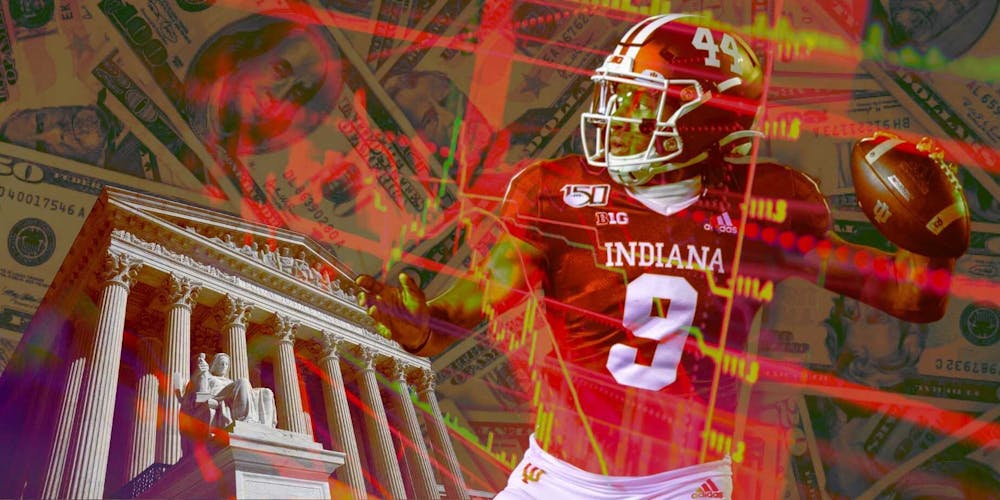The NCAA is in line for an overhaul.
The Supreme Court ruled Monday that the NCAA violated antitrust laws by limiting education-based benefits from collegiate athletes. A number of states are preparing to allow athletes to make money off their name, image and likeness (NIL). Now the ruling body of collegiate athletics is faced with a potential reset of how college sports exist.
Since college sports began and the NCAA was founded in 1906, collegiate athletics have run under a policy of amateurism. Historically, players have not been allowed to earn money from signing autographs or making public appearances and remain eligible to play in college.
Now seven states have passed NIL bills that go into effect July 1. Arizona’s law will go into effect July 23, and 12 more states have legislation set to go into effect by 2025. Indiana, meanwhile, has no plans to work an NIL bill through the legislature.
That impending date has put pressure on the NCAA and Congress to pass a law allowing NIL rules to take effect nationwide.
“Those who are in favor of a federal law will say that it provides the rules of the road that are equal for everybody,” Associate Athletic Director Jeremy Gray said. “Programs are not operating with a wildly different set of rules state to state which could lead to competitive imbalance.”
In other words, national legislation means the University of Florida — a state currently in line to adopt NIL rules — doesn’t have a recruiting advantage over IU — which does not have plans to adopt legislation — because players can get paid in the state of Florida if they play for the school.
For example, an IU athlete from Florida, like junior quarterback Michael Penix, suddenly has to balance his ability to make money based on which state he is in. National legislation prevents him from getting into trouble with the NCAA for a signing event in Florida because he goes to school in Indiana.
“A federal law that’s just a blanket across the board just becomes easier to navigate, easy to enforce,” Gray said.
Whether that national ruling comes, or if Indiana passes its own law, IU is ready to give its students an advantage on building a brand. Several years ago, IU partnered with Opendorse, a company that helps build athletes’ brands and maximize their value by allowing programs to deliver content to athletes, behind a push from IU Director of Social and Digital Media Lynnea Phillips.
“We’ve been doing this for a while,” Phillips said. “Football was all in from the beginning, but men’s basketball was right there too. We’ve been delivering content for our athletes since 2017, 2018.”
On Dec. 15, 2018, then-freshman guard Rob Phinisee hit a game-winning three at the buzzer to beat Butler University in the Crossroads Classic.
Through Opendorse, IU gave Phinisee the photo of the team celebrating. As soon as he left the court, Phinisee was able to hit send on this tweet, helping increase his engagement.
IU has done the same thing with head football coach Tom Allen’s post game speeches, the ones that make Indianapolis 500 drivers want to run through brick walls for him. Opendorse has allowed Allen to share his content and build a following on Twitter.
“We actually liked Opendorse before it was cool to like Opendorse,” Gray said.
In August, IU paired with Opendorse Ready, a NIL program tailored to each athlete to help the player understand his or her value. Through the program, IU has been able to brand all 24 of its sports.
“We were the first school in the country to have a task force related to NIL,” Gray said. “We were the second school in the country to have a brand building entity of the Opendorse Ready program.”
The task force includes 10 people associated with IU Athletics, including five coaches. Gray said IU is partnered with the Kelley School of Business and the Media School to educate the players on business and how to build their brand and the task force includes Kelley professor Ash Soni and Media School professor Galen Clavio.
“There’s some natural advantages of being the first mover there because you’re no longer reacting to what the big schools are doing, you’re actually reacting ahead of time,” Clavio said.
By having professors on the task force as well as athletic administrators, Clavio said IU is able to get perspectives outside of the department that have different backgrounds.
Clavio said the use of Opendorse, and specifically being ahead of the competition, appeals to athletes and recruits looking at IU.
“It’s also, let's just be honest, a little bit selfish,” Gray said. “Michael Penix puts out a great piece of content of him doing something well at Indiana or having fun at Indiana, that helps with recruiting. It tells our story.”
Going forward, Opendorse will also be the tool IU uses to keep compliance with the NCAA if the rules change, and provide ways for athletes to sponsor products through social media.
Phillips said IU’s social media team has been meeting with teams and athletes to get to know them better by asking about their number or their favorite music, helping them connect with the audience and build their brand.
“Every athlete is a brand. They have a brand whether they work on it or not,” Phillips said. “Really, we’re just empowering them to be proactive and take the reins on what their brand is.”




